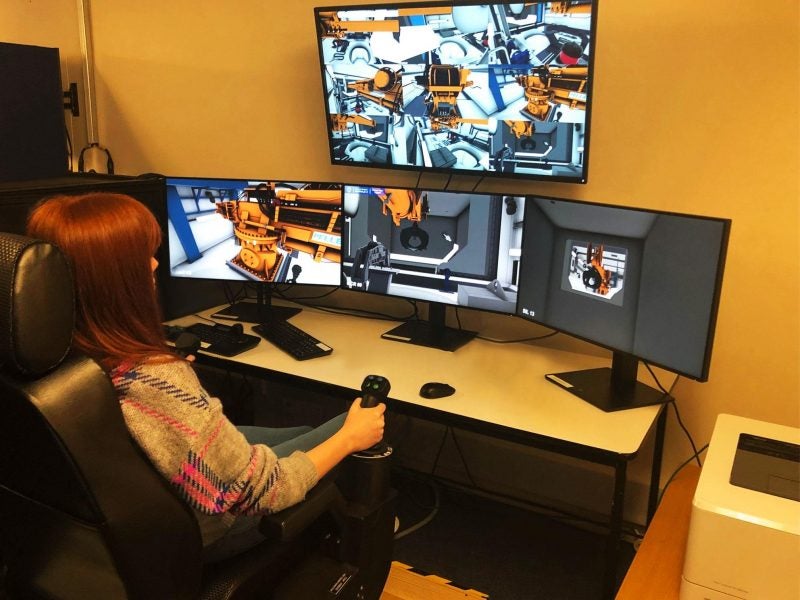
The idea of the mixed-technology crane came about after Virtual Engineering Centre’s (VEC) digital experts were approached by Sellafield, who were pondering how virtual reality could be used to safely train the specialist operators of its newly commissioned nuclear waste removal crane, designed to scoop up and remove nuclear waste from Sellafield’s 70-year-old Pile Fuel Cladding Silo.
VEC senior marketing manager Sarah Martin-Tyrell explains that Sellafield were developing two different projects at the time and while they were “dipping their toe in the water” trying out VR training, they were installing this “cutting silo crane”, which was used for decommissioning of nuclear waste.
“They came to the Engineering Centre, where we had a session and discussed the two different projects when we realized that we could leverage that and then came up with the VR technology within the crane system,” Martin-Tyrell recalls.
Design and benefits: mixed-reality for real world control
As the Sellafield building was originally designed to be permanently sealed, this sparked the demand for alternative access to retrieve the waste. As a result, experts at the VEC met with the Sellafield team at the VEC innovation centre at Sci Tech Daresbury, relying on an existing Sellafield 3D design models, created a simulator of the silo and crane.
The technology started by using an identical replica of the crane’s operator chair, control joystick, and spatial working environment.
“We had this virtual world exactly how it would be in the real world and we took the integration of the control system and applied the exact same facial movements and awareness to the same control stick, the same movement of the chair…”, Martin-Tyrell continues. “So that allowed for the operators to control the virtual environment from a real-world space and that’s why we call the technology mixed reality.”
In terms of its benefits, the crane training simulator has provided a realistic environment for Sellafield’s operators, allowing them to “drive” the nuclear waste retrieval crane in a safe environment, before the launch of the full-scale training programme. Martin-Tyrell explains: “Because we can train people in this kind of virtual mixed reality environment, we don’t have to take anybody out of the actual job to do that, which means – productivity benefits and making Sellafield safer.” In addition to that, the technology is believed to build operator confidence quicker and reduce the overall project delivery schedule.
Following the initial success of the simulator, Sellafield’s silo waste retrieval team has made the decision to use it as the primary tool for crane operator training. This has allowed for the company to re-purpose the training rig it had originally planned to use as a second retrieval system, which saves £20m on the cost of future waste retrievals.
Challenges and impacts: refining for maximum productivity
The creation of the technology has not been without its challenges
“Sometimes the design engineers would go inside the virtual system before commissioning, have a walk around and say: ‘Well, this is too close to that, the CCTV camera can go there, we need a bigger room or we need to move this 30 centimetres back .” she says.
Other challenges they encountered along the way were working across different stakeholder groups, establishing good communication, and generally “making sure everybody’s happy”.
Since its establishment, the mixed-reality technology has reaped rewards, being highly commended in the Safety in Innovation category at the Nuclear Decommissioning Authority Safety and Wellbeing Awards in 2019.
Martin-Tyrell also shares that during one of the latest trials, Sellafield was able to remove far more waste than expected in one day, thanks to the training simulator.
Looking into how the technology impacts the nuclear industry, Martin-Tyrell says that it certainly makes hazardous operations safer and more time-efficient. “I think this type of mixed reality, real life training can be applied to different fields to ensure similar cost-reductions and productivity rise,” she concludes.
In the meantime, the VR market is growing, with energy companies such as E.ON, ERPi and Duke Energy incorporating virtual reality elements in different stages of their operations.
According to Reportlinker, the VR market is estimated to grow at a compound annual growth rate of 33.47% between 2018 and 2024, driving the virtual reality market value from $7.9bn to $44.7bn, while it is also set to be worth more than five times its current value within five years.


